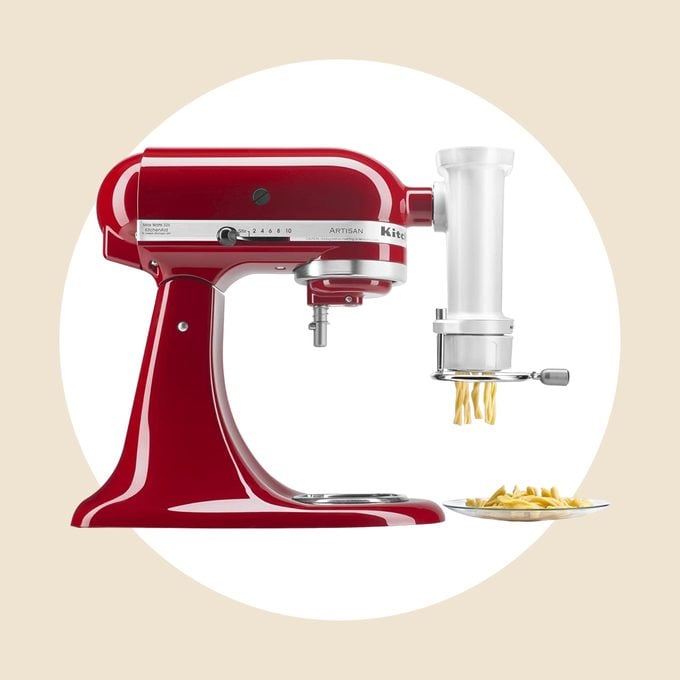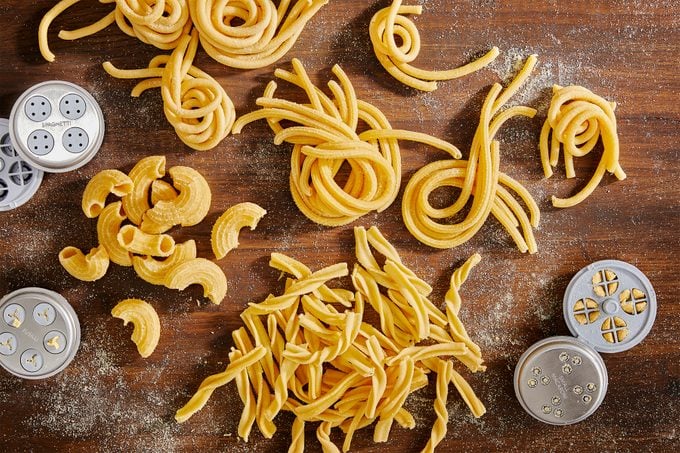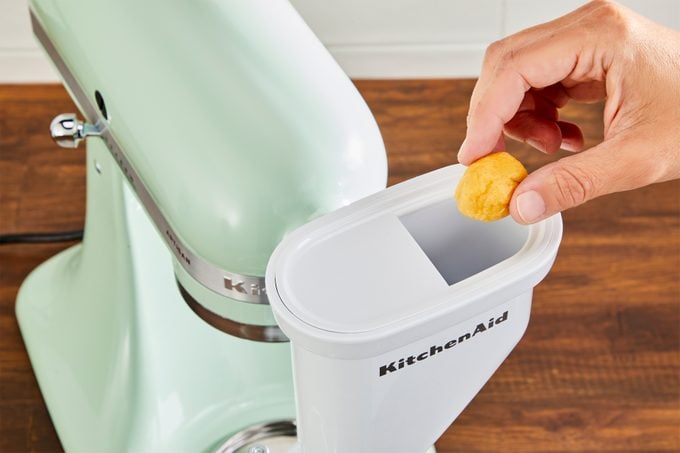We Tried a KitchenAid Pasta Press—And It’s the Gadget of Our Italian Dreams
Updated: Jun. 30, 2024

The nifty KitchenAid Pasta Press is a top-tier mixer attachment, according to our Executive Culinary Director. Read her full review to find out why, plus which pasta shape is her favorite.
Our editors and experts handpick every product we feature. We may earn a commission from your purchases.Learn more.
I believe cooking should be fun, so consider me a fan of any gadget or appliance that encourages a good time in the kitchen.
These past few years, I’ve had a blast tapping into my Easy-Bake Oven days with the ever-popular air fryer, which cooks food similarly to the childhood favorite. And now, I’m obsessed with the KitchenAid Pasta Press.
As I use the handy attachment, the Play-Doh-lover in me can’t help but be reminded of the many plates of “pasta,” however inedible, I prepared as a kiddo. The plug-and-chug nature of the KitchenAid gadget makes it nearly as simple to use as the plastic Hasbro toy, but the finished product is a whole lot tastier.
That’s why the Pasta Press is among my top three of more than a dozen KitchenAid attachments.
What is a KitchenAid Pasta Press?
Not to be confused with the KitchenAid Pasta Roller & Cutter, the Pasta Press is a doodad that attaches to any (yes, any!) KitchenAid stand mixer, thanks to the appliance’s universal power hub. I have my grandma’s bright-white mixer from the ’70s and was dubious the Pasta Press would fit—I was delighted to stand corrected.
The attachment, which affixes to the knob on the front of the stand mixer, is operated by the same speed lever that’s used for regular mixing and whipping.
As its name would suggest, the Pasta Press presses balls of fresh pasta dough into various shapes that are then cut and tossed into boiling water to cook.
 VIA MERCHANT
VIA MERCHANT
We Tried It
KitchenAid Gourmet Pasta Press Attachment
KitchenAid Pasta Press Features
The Pasta Press weighs around 3 pounds, stands roughly 10 inches tall and arrives in a storage case that masterfully fits all the included parts.
The parts in question? A pasta press (with a plastic auger and pasta ring), dough pusher, cleaning tool and six interchangeable pasta discs. At the base of the pasta press, the wire cutter horizontally slices the pasta pieces off the machine as they’re dispensed. (Psst! Keep your other KitchenAid attachments organized with this $11 Amazon item.)
Each of the six discs produces a different pasta shape, including bucatini, spaghetti, rigatoni, large or small macaroni or fusilli.
The dough pusher is also dual-purpose, despite its specific name. Yes, it helps users push the dough balls further into the cavity, but it also works as a wrench to remove and swap out the pasta discs with added ease.
The pointy stainless-steel cleaning tool is essential for removing all dough remnants from the fickle nooks and crannies. Hold onto it!
How We Tested It

Practice makes perfect pasta. That’s the saying right? Well, I’ve practiced with this device a ton, and it’s made some dang-near-perfect pasta. (The rigatoni is my favorite because the grooves cling onto the sauce for a delightful blast of flavor in every bite!)
Prepping the Dough and Space
I start by making the dough recipe found in the user guide—it’s a great consistency for the machine. You want your dough to be firm and not sticky or soft. Then, I roll my dough into balls. The manual instructs users to make walnut-sized balls and be sure to take this literally. Forming the dough balls too large or too small can cause production issues.
I particularly like to make these walnut-sized balls ahead of time and place them in the fridge until ready to use. This splits up the process and makes homemade pasta-making feel less daunting.
However, don’t go so far as to prep the shaped pasta ahead of time. I’ve found that the formed noodles can become discolored in the fridge. Instead, pull the pre-made balls from the fridge, drop them into the Pasta Press, then boil the freshly formed noodles immediately.
Before I turn the mixer—and, in turn, the Pasta Press—on, I place a floured baking sheet directly below the attachment. (A silicone baking mat or piece of parchment paper also works.) This provides me an easy, nonstick spot to pile my homemade creations.
Using the Pasta Press

Once it’s time to begin and the attachment is fitted with the pasta disc of my choice, I load the walnut-sized nuggets, a few at a time, into the portion of the Pasta Press officially referred to as the “housing base.”
Next, I flip the speed lever to the appropriate level. For rigatoni, I use the sixth speed. From the housing base, the balls travel through the auger and begin to squeeze through the openings of the pasta disc. Note: If things get backed up, the balls might need a little coaxing from the dough pusher.
When the pasta is the appropriate length (e.g., for rigatoni, this is about 1.5 inches), I swipe the wire cutter across the surface of the pasta disc using the tab. The pasta pieces fall right onto my prepared nonstick surface. Voila! Into the boiling water they go.
Cleaning the Pasta Press
After my cooked, piled-high pasta, most likely doused in my favorite store-bought pasta sauce, is all gone, it’s time to clean. Admittedly, this is the not-so-fun part. The stainless-steel tool makes cleaning the pasta discs easier, and I suggest a soapy washcloth for the wire cutter and housing base. Thankfully, the pasta ring, auger and dough pusher are all dishwasher-safe.
Pros
- Compatible with any model of KitchenAid stand mixer
- Easy to assemble and use
- Six pasta discs
- Smart packaging
- Some dishwasher-safe components
Cons
- Loud while in use
- High price point
- A little tedious to clean, though the provided tool helps
FAQs
Does KitchenAid have a pasta maker?
Yes, KitchenAid has two pasta-maker attachments. The first is the Pasta Press, which presses balls of fresh dough into six types of pasta, including spaghetti, rigatoni, large or small macaroni, bucatini or fusilli.
The second pasta-maker attachment is the Pasta Roller & Cutter. This device flattens fresh pasta dough into sheets of your desired thickness, then cuts said sheets into long noodles, either spaghetti or fettuccine. You can also cut the sheets freehand into lasagna noodles or any other flat shape you desire.
What can I do with KitchenAid pasta attachment?
Together, the KitchenAid pasta attachments can make up to seven shapes of noodles. The attachments are friendly to dietary restrictions as they easily churn out pasta made with traditional and nontraditional flours.
Moreover, homemade pasta in any form is impressive and delicious, but I love experimenting with tomato and spinach dough to create eye-catching finished dishes.
Lastly, these attachments go beyond pasta. I like using the Roller & Cutter to make gourmet crackers. I feed the seedy, nutty dough into the roller, then cut the sheets into squares to bake and snack on. Yes, this means that, much like the sifter attachment, the Pasta Press is also a great KitchenAid accessory for bakers.
What speed for KitchenAid Pasta Press?
My number one tip: Follow the manual. I’ve had the most success with KitchenAid’s dough recipe, which indicates each pasta shape should be produced on a different speed setting.
I made the mistake of starting out my spaghetti on a speed lower than 10 (which is what’s recommended) out of fear that the noodles would go flying. Alas, the elevated speed is necessary for spaghetti and bucatini.
Rigatoni and both macaronis, however, call for a speed of 6. And the fusilli needs a speed of 3.
What Other Reviewers Had to Say
KitchenAid is a trusted brand in the culinary space—and this awesome product only reinforces that reputation. Like the stand mixer before it, the Pasta Press has received plenty of praise online.
“I’m so happy I purchased this mixer!” writes Debbie in her five-star review. “After we downsized and I gave away my old KitchenAid for lack of counter space, I really missed it. After about eight years and moving to another home, I treated myself, bought another KitchenAid of course, and have used it multiple times each week since.”
Verified Amazon purchaser Traci writes, “We love making fresh pasta, and several years ago we purchased the earlier version of this product. We used it frequently and literally wore it out. It’s even better than the original. The design is similar, but overall just a little sturdier, plus it comes with a cleaning tool that makes cleaning much easier! I’m thrilled with this purchase.”
Richard P. says the Pasta Press is great family fun, “I have used this attachment three times so far and it works great! And it’s a lot of fun. My daughter really enjoys kneading the dough because it smells so good. We made a big batch of noodles two days ago, and I put the uncooked noodles in the refrigerator. I used them for soup tonight, and besides being delicious, I had to smile thinking about the fun we had making them. I highly recommend this product. Using this machine feels like you are playing with Play-Doh, but you get to eat it.”
Product Comparison
The most direct comparison is between the two KitchenAid pasta attachments, and you might be wondering which is worth it. I’ve used both the Roller & Cutter and the Pasta Press, and I’d opt to spend my money on the latter.
I find its versatility more appealing, and the shaped pastas are just so satisfying to make. Plus, between the bucatini and spaghetti discs, you can still make long noodles comparable to those the Roller & Cutter produces.
In terms of how it compares to standalone pasta makers and tools, my line of thinking is this: Any pasta maker worth its salt is a similar price point. So if you have a KitchenAid stand mixer, you might as well go with this one. It has a smaller footprint than a standalone pasta maker, all while getting the job done just as well, if not better.
Final Verdict
I eat pasta all the time—a habit passed down by my aforementioned KitchenAid-toting grandma. So having the Pasta Press in my repertoire just makes sense, and I’d say the same for anyone else with serious pasta cravings.
It’s intuitive to assemble—I didn’t need to rely on the manual much. That being said, I do recommend perusing the user guide for recipes, tips and speed/sizing guidelines.
Thanks to the dough pusher, wire cutter and cleaning tool, it’s also super straightforward to use and clean. The disc options mean there’s a pasta shape for just about any sauce or personal preference.
Don’t be deterred by the price tag if you’re a KitchenAid connoisseur or noodle-lover—it’ll be in constant use in your kitchen. (Plus, KitchenAid is known to have sweet sales.)
Where to Buy the KitchenAid Pasta Press
 VIA MERCHANT
VIA MERCHANT
We Tried It
KitchenAid Gourmet Pasta Press Attachment
The Pasta Press is available for $220 from Amazon, KitchenAid, Williams Sonoma and Crate & Barrel. Pasta might be seriously delicious, but you’ll have so much fun getting fu-silly in the kitchen with this tool.




















